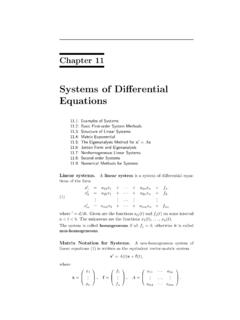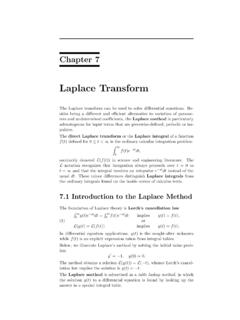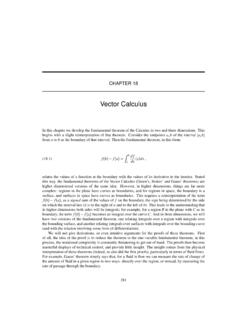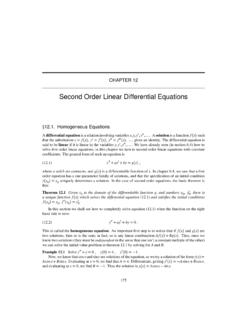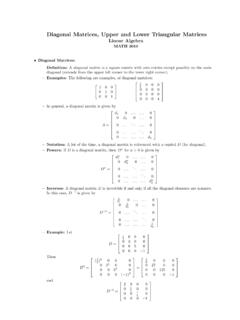Transcription of Rotation Matrices - University of Utah
1 Rotation Matrices vi 0. 0. 4. Suppose that 2 R. We let R : R 2 ! R2. vi C. vi 0. 0. be the function defined as follows: 4. Any vector in the plane can be written in polar coordinates as r(cos( ), sin( )). where r 0 and 2 R. For any such vector, we define vi C. c). R r( cos( ), sin( ) ) = r( cos( + ), sin( + ) ). Notice that the function R doesn't change the norms of vectors (the num- ber r), it just a ects their direction, which is measured by the unit circle c). coordinate. We call the function R Rotation of the plane by angle . +. 0. +. +. vi vi 0. 0. 4. +. 0. +. +. vi C. vi C. vi 0. 0. 4. c). 0. A. vi C. c). If > 0, then R rotates the plane counterclockwise by an angle of . If < 0, then R is a clockwise Rotation by an angle of | |. The Rotation does 0. +. v-b +. 0. 0. +. +.
2 Vi not a ect the origin in the plane. That is, R (0, 0) = (0, 0) always, no matter which number is. 258. 0. +. +. vi Examples. R 2 is the function that rotates the plane by an angle of 2 , or 90 . Because 2 > 0, it is a counterclockwise Rotation . Thus, R 2 (1, 1) is the point in the plane that we obtain by rotating (1, 1) counterclockwise by an angle of 2 . I . (H). a . S. Because 2 < 0, R 2 is a clockwise Rotation . R 2 (1, 1) is the point in the plane obtained by rotating (1, 1) clockwise by an angle of 2 . (I,'). The function R0 : R2 R2 rotates the plane by an angle of 0. That is, it doesn't rotate the plane at all. It's just the identity function for the plane. 259. Below is the picture of a shape in the plane. It's a triangle, and we'll call this subset of the plane D. D.
3 R 2 (D) is the set in the plane obtained by rotating D counterclockwise by an angle of 2 . (It's counterclockwise because 2 > 0.). R 4 (D) is D rotated clockwise by an angle of 4 . 260. Let's rotate the vector (a, 0), where a 0. This is a point on the x-axis whose norm equals a. I (i,o) (ao'):o.(l,o). We can write this vector in polar coordinates as a(1, 0), or equivalently, as a( cos(0), sin(0) ). Now we can rotate the vector (a, 0) by an angle . That's (o'i)v: the vector R (a, 0), which by the formula from the beginning of this chapter is (o'i)v: . R (a, 0) = R a( cos(0), sin(0) ). = a( cos(0 + ), sin(0 + ) ). (o'i)v: (o'z) = a( cos( ), sin( ) ). (o'i)v: (o'z) . 0 (o'z) . 0 (o'z) . (o'i)v: In this example, we'll rotate a vector (0, b), where b 0. This is a vector whose norm equals b, and that points straight up.
4 In polar coordinates, . (0, b) = b( cos 2 , sin 2 ). 0 (o'z) . (o,). fir a 261. Now if we rotate (0, b) by an angle , then we have . R (0, b) = R b cos , sin 2 2 . = b cos + , sin + . 2 2.. = b cos + , sin +. 2 2. There's a slightly better way to write the result above, but it requires a cou- ple of the identities we learned in the chapter Sine and Cosine . Specifically, Lemmas 8-10 tell us that . cos + = cos + . 2 2. = sin( + ) [Lemma 9]. = sin( ) [Lemma 10]. and . sin + = cos( ) [Lemma 8]. 2. Therefore, . R (0, b) = b cos + , sin + = b( sin( ), cos( ) ). 2 2. (o,). cos (oc)). * * * * * * * * * * * * *. 262. Composing rotations It's rare for a function to satisfy any sort of nice algebraic rule. We know a few functions that do powers (xn y n = (xy)n ), exponentials (ax ay =.
5 Ax+y ), and logarithms (loga (x) + loga (y) = loga (xy)) and rotations provide another example, as the following theorem states. Theorem (14). R R = R + . Proof: If first we rotate the plane by an angle of , and then we rotate the plane by an angle of , we have rotated the plane by an angle of + . That's what this theorem says.. Example. If we rotate the plane counterclockwise by an angle of 3 , and then I. we rotate counterclockwise by an angle of , we've rotated counterclockwise a total angle of + 3 = 4 . 3 . That's what Theorem 14 says, R R 3 = R 3 . I. 4 . I. RLhr 3. 263. Corollary (15). R 1 = R . Proof: As discussed at the bottom of page 259, the Rotation R0 is a Rotation by an angle of 0, which means R0 doesn't rotate anything at all. It's the identity function on the plane.
6 That is, R0 = id. Using Theorem (14) we see that R R = R = R0 = id and R R = R + = R0 = id Summarizing the above line, we have R R = id and R R = id Recall that the definition of inverse functions is that they satisfy the rela- tionship f f 1 = id and f 1 f = id We have seen that the functions R and R satisfy this relationship, so they are inverse functions. That is, R 1 = R . Intuitively, Corollary 15 states that the opposite of rotating the plane by , is rotating the plane by . * * * * * * * * * * * * *. 264. Rotations are Matrices We know what the Rotation function R : R2 R2 does to vectors written in polar coordinates. The formula is . R r( cos( ), sin( ) ) = r( cos( + ), sin( + ) ). as we saw at the beginning of this chapter. What's less clear is what the formula for R should be for vectors written in Cartesian coordinates.
7 For example, what's R (3, 7)? We'll answer this question below, in Theorem 17. Before that though, we need one more lemma. Lemma (16). For vectors (a, 0) and (0, b), we have . R (a, 0) + (0, b) = R (a, 0) + R (0, b). Proof: One way to find the sum of (a, 0) and (0, b) is draw the rectangle that they form. The sum of (a, 0) and (0, b) will be the corner of the rectangle that is opposite the corner at the origin. (,o) + (0, b (o,b) - (a,o). Similarly, the sum of R (a, 0) and R (0, b) is found by drawing the rectangle that they form.. \ o). 265. Below is the first rectangle we drew in this proof, after being rotated by and angle of . \. Notice that it's the same rectangle as the second one that we drew, it's just that the corner opposite the origin is labeled differently. Since they are the same rectangle, the opposite corners are the same, so R (a, 0) + (0, b) =.
8 R (a, 0) + R (0, b), which is what we had wanted to show.. Now we are ready to describe the Rotation function R using Cartesian coordinates. We will see that R can be written as a matrix, and we already know how Matrices affect vectors written in Cartesian coordinates. Theorem (17). R : R2 R2 is the same function as the matrix function . cos( ) sin( ). sin( ) cos( ). For short, . cos( ) sin( ). R =. sin( ) cos( ). Proof: To show that R and the matrix above are the same function, we'll input the vector (a, b) into each function and check that we get the same output. First let's check the matrix function. Writing vectors interchangeably as row vectors and column vectors, we have that . cos( ) sin( ) cos( ) sin( ) a (a, b) =. sin( ) cos( ) sin( ) cos( ) b . a cos( ) b sin( ). =.
9 A sin( ) + b cos( ).. = a cos( ) b sin( ) , a sin( ) + b cos( ). 266. Now let's check that we obtain the same output if we input the vector (a, b). into the function R . What we'll use is Lemma 16 and the two examples from pages 261 and 262. that showed us R (a, 0) = a( cos( ), sin( ) ) and R (0, b) = b( sin( ), cos( ) ). We can now check that . R (a, b) = R (a, 0) + (0, b). = R (a, 0) + R (0, b) [Lemma 16].. = a cos( ), sin( ) + b sin( ), cos( ) [Examples].. = a cos( ), a sin( ) + b sin( ), b cos( ).. = a cos( ) b sin( ) , a sin( ) + b cos( ). Because the matrix and the function R gave us the same output, they are the same function.. Examples. We can write R , Rotation by , as a matrix using Theorem 17: . cos( ) sin( ) 1 0. R = =. sin( ) cos( ) 0 1. Counterclockwise Rotation by 2 is the matrix.
10 Cos( 2 ) sin( 2 ) 0 1. R 2 = =. sin( 2 ) cos( 2 ) 1 0. Because rotations are actually Matrices , and because function composition for Matrices is matrix multiplication, we'll often multiply Rotation functions, such as R R , to mean that we are composing them. Thus, we can write Theorem 14 as R R = R + . * * * * * * * * * * * * *. 267. Angle sum formulas Theorem 14 tells us that R + = R R . Theorem 17 allows us to write this equation with Matrices , that we can then multiply: . cos( + ) sin( + ) cos( ) sin( ) cos( ) sin( ). =. sin( + ) cos( + ) sin( ) cos( ) sin( ) cos( ).. cos( ) cos( ) sin( ) sin( ) cos( ) sin( ) sin( ) cos( ). = . sin( ) cos( ) + cos( ) sin( ) sin( ) sin( ) + cos( ) cos( ). The top left entry of the matrix we started with has to equal the top left entry of the matrix that we ended with, since the two Matrices are equal.
